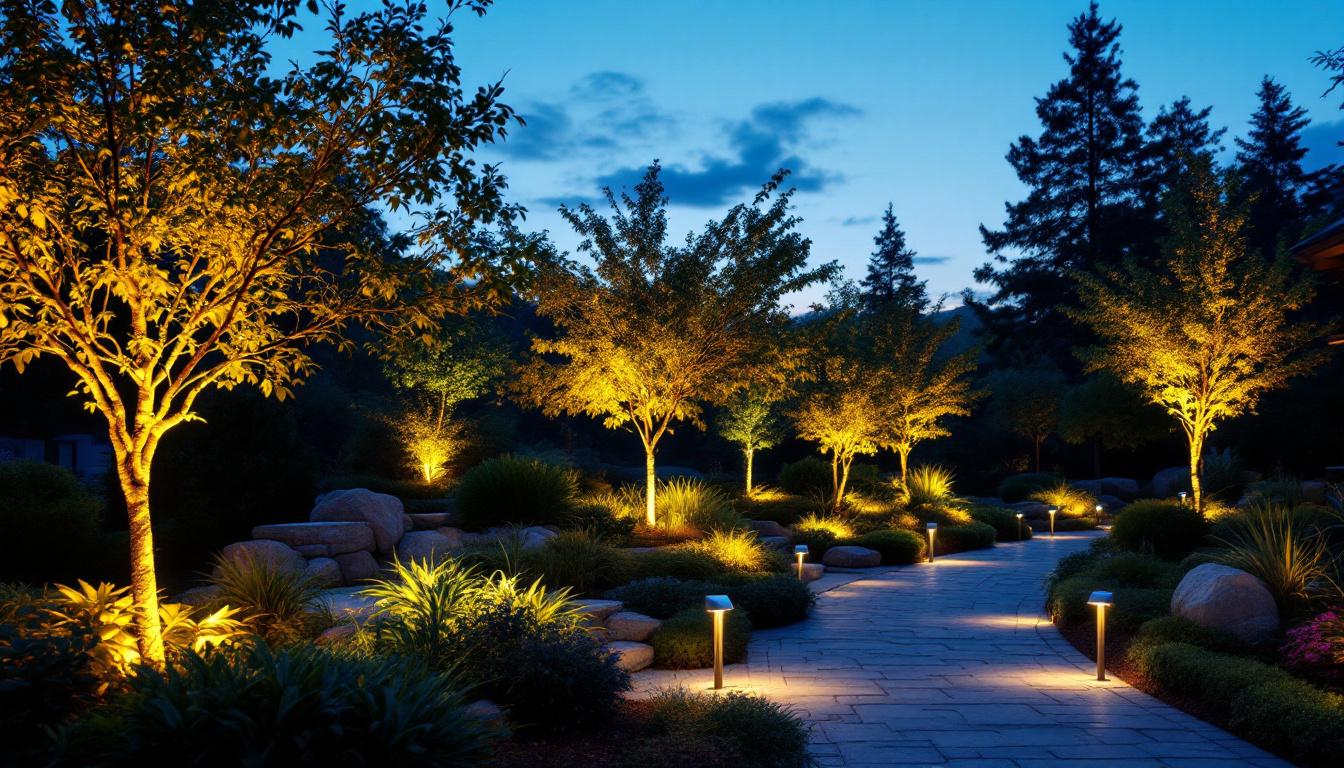
In the evolving landscape of outdoor lighting, solar uplighting has emerged as a popular choice among homeowners and businesses alike. With its eco-friendly attributes and cost-effective nature, it presents a unique opportunity for lighting contractors to enhance their service offerings. This article explores the top strategies that lighting contractors can employ to maximize the benefits of solar uplighting, ensuring both aesthetic appeal and functionality.
Solar uplighting refers to the use of solar-powered fixtures to illuminate landscapes, architectural features, and outdoor spaces. These fixtures harness sunlight during the day, converting it into energy to power LED lights at night. This not only reduces electricity costs but also minimizes the carbon footprint associated with traditional lighting solutions. The technology behind solar uplighting has advanced significantly, with many modern fixtures featuring built-in sensors that automatically turn the lights on at dusk and off at dawn, further enhancing their energy efficiency and convenience for users.
For lighting contractors, understanding the mechanics of solar uplighting is essential. Familiarity with the various types of solar lights available, their installation requirements, and their operational limitations can significantly enhance service quality. Moreover, staying informed about advancements in solar technology can provide contractors with a competitive edge. As battery technology improves, many solar uplighting fixtures now offer longer run times and brighter outputs, making them a more viable option for a wider range of applications, from residential gardens to commercial properties.
There is a diverse range of solar uplighting fixtures available, each designed for specific applications. Path lights, spotlights, and floodlights are among the most common types. Path lights are ideal for illuminating walkways and gardens, while spotlights are perfect for highlighting architectural features or trees. Floodlights can cover larger areas, making them suitable for patios or driveways. Additionally, some fixtures come with adjustable heads or interchangeable lenses, allowing for greater versatility in lighting design and effects.
Contractors should consider the unique requirements of each project when selecting fixtures. Factors such as the desired brightness, color temperature, and beam angle can influence the overall effectiveness of the lighting design. Furthermore, the aesthetic appeal of the fixtures themselves can play a significant role in client satisfaction. Many manufacturers offer a variety of styles and finishes, ensuring that solar uplighting can complement the existing landscape and architecture. Understanding the specific needs of clients can help in recommending the most suitable products, ensuring that the final installation not only meets functional requirements but also enhances the visual appeal of the space.
Proper installation is crucial for the performance of solar uplighting systems. Contractors must assess the site conditions, including sunlight exposure, to ensure optimal energy absorption. Areas with significant shade from trees or buildings may require alternative solutions or additional fixtures to achieve the desired lighting effect. Additionally, the orientation of the solar panels should be considered, as panels facing south typically receive the most sunlight, maximizing energy collection.
Furthermore, it’s essential to follow manufacturer guidelines during installation. This includes positioning the solar panels for maximum sun exposure and ensuring that the fixtures are securely mounted. By adhering to best practices, contractors can enhance the longevity and efficiency of the solar lighting systems they install. Regular maintenance checks, such as cleaning the solar panels and replacing batteries when necessary, can also help maintain optimal performance over time. As the popularity of solar lighting continues to grow, being knowledgeable about these aspects can set a contractor apart in a competitive market, fostering trust and satisfaction among clients.
Effective design is key to maximizing the aesthetic appeal and functionality of solar uplighting. Lighting contractors should focus on creating a balanced and harmonious lighting scheme that enhances the natural beauty of the landscape while providing adequate illumination.
Incorporating various lighting techniques, such as silhouetting, shadowing, and spotlighting, can create depth and dimension in outdoor spaces. By strategically placing fixtures, contractors can draw attention to focal points, such as trees, sculptures, or architectural elements, while maintaining a warm and inviting atmosphere.
Layering light involves combining different types of lighting to create a more dynamic and versatile outdoor environment. For instance, a combination of uplights, path lights, and ambient lighting can provide both functional and decorative illumination. This approach not only enhances the visual appeal but also allows for flexibility in how spaces are used at night.
Contractors should encourage clients to think about how they intend to use their outdoor spaces after dark. Whether it’s for entertaining guests or simply enjoying a quiet evening, understanding the purpose of the space can guide the selection and placement of lighting fixtures.
As technology continues to advance, integrating smart features into solar uplighting systems has become increasingly popular. Smart solar lights can be controlled remotely via smartphone apps, allowing users to adjust brightness levels, set timers, and even change colors. This level of customization can enhance user experience and satisfaction.
For lighting contractors, offering smart solar lighting solutions can differentiate their services from competitors. By staying informed about the latest technological advancements, contractors can provide clients with innovative options that meet their needs and preferences.
While solar uplighting systems are generally low-maintenance, some upkeep is necessary to ensure optimal performance. Lighting contractors should educate clients about the importance of regular maintenance, including cleaning solar panels and checking for any obstructions that may block sunlight.
In addition, understanding common issues that may arise with solar lights can help contractors provide better service. For instance, if lights are not functioning as expected, it may be due to insufficient sunlight exposure or battery issues. By being proactive in addressing these concerns, contractors can enhance customer satisfaction and build long-term relationships.
Client education plays a vital role in the successful implementation of solar uplighting. Contractors should take the time to explain how solar lights work, their benefits, and any limitations. This transparency helps set realistic expectations and fosters trust between contractors and clients.
Providing clients with maintenance tips and troubleshooting guidance can also empower them to take care of their solar lighting systems. This not only enhances the longevity of the fixtures but also reinforces the contractor’s reputation as a knowledgeable and reliable professional.
Seasonal changes can impact the performance of solar uplighting systems. Contractors should advise clients on how to adjust their lighting setups based on seasonal variations in sunlight availability. For example, during the winter months, when days are shorter, clients may need to reposition fixtures or consider additional lighting options to maintain adequate illumination.
By being proactive about seasonal adjustments, contractors can help clients maximize the effectiveness of their solar uplighting throughout the year. This level of service can lead to repeat business and referrals, ultimately benefiting the contractor’s bottom line.
As more homeowners and businesses seek sustainable lighting solutions, marketing solar uplighting services effectively is essential for lighting contractors. A well-crafted marketing strategy can help attract new clients and establish a strong brand presence in the community.
Contractors should leverage various marketing channels, including social media, websites, and local advertising, to showcase their solar lighting projects. High-quality images of completed installations can highlight the aesthetic appeal of solar uplighting and demonstrate the contractor’s expertise.
Creating a comprehensive portfolio of past projects can serve as a powerful marketing tool. Contractors should document their work, including before-and-after photos, client testimonials, and detailed descriptions of each project. This not only showcases their skills but also provides potential clients with a clear understanding of the contractor’s capabilities.
In addition to a physical portfolio, an online presence is crucial. A well-designed website featuring a gallery of completed projects can attract more visitors and generate leads. Incorporating educational content about solar uplighting can also position the contractor as an authority in the field.
Networking with other professionals in the industry can lead to valuable partnerships that enhance a contractor’s service offerings. Collaborating with landscape architects, builders, and real estate agents can create referral opportunities and expand the contractor’s reach.
Participating in local events and trade shows can also help contractors connect with potential clients and showcase their expertise. By building a strong network, contractors can increase their visibility and credibility in the market, ultimately leading to more business opportunities.
The solar lighting industry is continuously evolving, with new trends and technologies emerging regularly. Lighting contractors should stay informed about these developments to remain competitive and offer the best solutions to their clients.
One notable trend is the increasing integration of solar technology with energy storage systems. This advancement allows solar lights to store excess energy for use during cloudy days or at night, enhancing their reliability and performance. Contractors should be prepared to discuss these innovations with clients, highlighting the benefits of investing in advanced solar lighting systems.
As environmental consciousness grows, more clients are seeking sustainable solutions for their outdoor lighting needs. Contractors can capitalize on this trend by emphasizing the eco-friendly attributes of solar uplighting in their marketing efforts. Highlighting the reduction in energy consumption and carbon emissions can resonate with environmentally conscious clients.
Incorporating sustainability into the overall business model can also enhance a contractor’s reputation. By actively promoting green practices and solutions, contractors can position themselves as leaders in the industry, attracting clients who prioritize sustainability.
Consumer preferences are constantly changing, and lighting contractors must be agile in adapting to these shifts. Understanding the latest design trends, color preferences, and technological advancements can help contractors tailor their services to meet evolving client demands.
Conducting surveys or gathering feedback from clients can provide valuable insights into their preferences. By staying attuned to the market, contractors can offer innovative solutions that resonate with their target audience, ultimately driving business growth.
Solar uplighting presents a unique opportunity for lighting contractors to enhance their service offerings while promoting sustainability. By understanding the mechanics of solar lighting, employing effective design strategies, and staying informed about industry trends, contractors can maximize the benefits of solar uplighting for their clients.
Moreover, by focusing on client education, maintenance, and marketing efforts, contractors can build a strong reputation and foster long-term relationships with their clients. As the demand for sustainable lighting solutions continues to grow, contractors who embrace solar uplighting will be well-positioned for success in the ever-evolving landscape of outdoor lighting.
Ready to elevate your lighting projects with the most sustainable and cost-effective solutions? Look no further than LumenWholesale, where we provide lighting contractors with spec-grade solar uplighting products at unbeatable wholesale prices. Our commitment to quality and affordability means you can deliver exceptional lighting experiences to your clients without the burden of inflated costs. Plus, with free shipping on bulk orders, you can stock up on premium lighting essentials and enjoy the best value with no hidden fees. Don’t compromise on quality or cost—choose LumenWholesale for all your lighting needs. Wholesale Lighting at the Best Value is just a click away.

Discover why ceiling fans are an essential consideration for lighting contractors.

Discover the essential insights lighting contractors need about solar light bulbs for outdoor use.

Discover the latest trends in outdoor house lighting that every lighting contractor needs to know.

Discover how motion sensor floor lights boost efficiency, safety, and client satisfaction for lighting contractors.